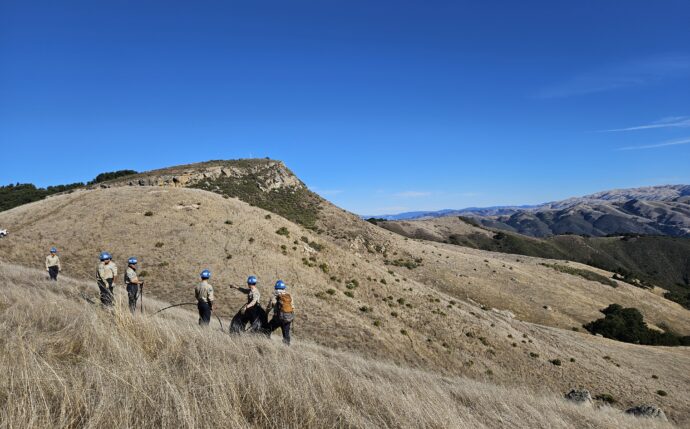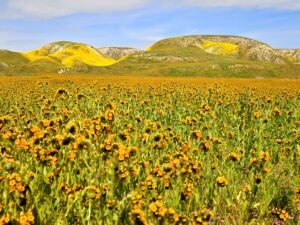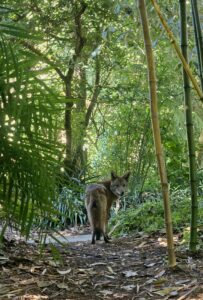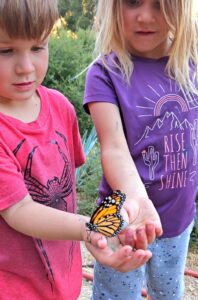
Language for movement making: What does Landscape Stewardship mean to you?
Connor Jandreau, California Central Coast Joint Venture* * * *
Our colleagues at the California Landscape Stewardship Network use “landscape stewardship” to speak to the encompassing nature of our shared work of bringing people together to build a collective conversations around how we wish to shape our relationship to place/land into the future. This Perspectives piece is adapted from remarks shared during a November 2024 CLSN convening.
* * * *
Stewardship as a word is frequently traced to Christian theology framed around sustaining one’s faith, though its true origins in Old English etymologically translates to ‘care of house or ward’. We often fast forward to the early 20th century Leopoldian land ethic as the point of departure from theological readings on stewardship, turning instead towards the more land-centric view conceptualizing sustainable use of natural resources and the relationships entwined therein. This of course negates the centuries of Indigenous knowledge underpinning place-based relationships, but we will address that below.

Carrizo Planes in bloom.
It has only been in the last few decades, however, where we have borne witness to the exponential use of the word within the conservation sector, in large part, through its branding as a more effective way to ‘access’ agricultural producers and confront the lack of social capital that environmentalism has suffered more broadly.
Aversion to words such as conservation (radical animal rights), sustainability (anti-capitalism), protection (tree-huggers), even climate change (fearmongering) has at least in part encouraged a shift in language by many in the conservation field. Employing “stewardship” instead of “conservation” has strengthened buy-in from communities important for the success of wildlife recovery and habitat restoration, be they landowners, agriculturalists, working lands purveyors and their associated advocates. It has indeed been quite successful in expanding the tent, gaining allies in conservation-minded landowners and has arguably led to a strengthening of bi-partisan conservation vehicles such as USDA’s Farm Bill and the Inflation Reduction Act.

Coyote in San Francisco.
In its most common association, stewardship pertains only to the landed, those whom own or ‘manage’ lands and waters. As many of us practitioners can attest, good stewardship requires money, planning and strong relationships to meet land management goals. Stewardship therefore often favors those that have the wherewithal to access conservation incentive programs and funding, directly or indirectly underscoring inequities in property ownership and ultimately preserving power imbalances inherent in this field.
At its worst, stewardship can inadvertently contribute to a dominant dialogue of erasure and thereby directly undermine Indigenous sovereignty and cultural lifeways, whose teachings on relationships and reciprocity with and among other beings is continually co-created, having begun millennia before Leopold mused about intelligent tinkering. Consider, for instance, the subtle but real distinction in the United States between co-stewardship, loosely defined as shared collaboration across a broad range of activities with the intent to include Indigenous knowledge and decision-making into resource governance; and co-management, as the formalized, legally binding, power-sharing agreement between Federal/State agencies and Indigenous Nations.
At the very least, we must ask whether the mainstream application of stewardship narrows the view of practitioners as we seek to collectively improve human and ecological wellbeing. Perhaps the true beauty of the word stewardship is in its plurality. In our current culture of divisiveness and division barreling down a seemingly perilous course, there truly is power in those words that mean more than first appears. Words matter. Words that can resist co-optation simply because they have the elasticity to embrace so many, and different, meanings for different people, and yet be stitched together with common thread. Stewardship is both traditional and progressive, grand and minute, process and outcome, profession and lifeway. We can truly define stewardship in so many ways…
For some stewardship is defined…
As community – stewardship as a gluing agent building fellowship with and within others, through a commonality of shared responsibility, goals and visions for one another.
As resistance – stewardship as an act of rebellion against the cultural ‘norms’ of extractivism, of accumulation, of individualism.
As honor – stewardship as virtuous, embodying associations of integrity, morality, honesty, and principle. As a model of respect for oneself and those around us.
As justice – stewardship as restorative practice, dismantling power imbalances, reclaiming community cohesion, and challenging structural inequalities.
For others, perhaps…
As faith – stewardship as responsibility to wisely manage resources, including finances, time, talents, and the environment, in recognition of the gifts of (a) creator(s).
As patriotism – stewardship as an extension of commitment to and support for the health and happiness of one’s country.
As economy – stewardship as the base of economic sustainability, building new and refurbishing old economies through realignment of priorities that recognize ecological processes underpin long-term prosperity.
As culture and life way – stewardship as an integrated part of navigating the world. Being a steward as an identity we can all hold. Proclaiming our personal and collective stewardship responsibilities inherent in being a part, rather than separate from, our community of life, human and non.
If we indeed seek to build a landscape stewardship movement, then we are called to expand the notion of what stewardship entails, to erode boundaries, real or perceived, within which we often limit ourselves. We must ask how the work we do intersects with the unfamiliar, be it sectors, lifeways, theologies, or philosophies.
The future of good stewardship requires a remaking of our collective day-to-day realities; blurring social, cultural, ecological and institutional boundaries.

Releasing a hatched monarch.
Stewards build consensus and encourage the cross-sector collaboration necessary to create lasting change. I would argue this stewardship movement needs not only to borrow from, but indeed swallow, or be swallowed by health, community advocacy, environmental justice, and diverse cultural knowledges so we may together influence domineering narratives. Ultimately, a landscape stewardship movement is about changing the way we understand our role on this planet, between and among each other, and the beings whom we depend upon and who depend upon us.
It follows that tenants of a landscape stewardship movement would include:
- accessible to everyone in tangibly and obvious ways, and relevant to an individual’s daily life, regardless of where one lives or what one does
- cross-sectoral and active in its pursuit of a plurality of knowledge systems
- influential at the practitioner level, but also at political and socio-cultural levels
- systems-oriented, power sensitive, and unafraid to question current systems of injustice and inequity

The work and play of restoration.
Perhaps readers are following the recent ‘threatened’ listing status recommendation by the U.S. Fish and Wildlife Service for the Monarch Butterfly—an insect so ubiquitous across the contiguous U.S.A, that there is concern of this listing potentially impacting virtually every acre coast to coast. As one observer noted in response to the listing recommendation: “We are going to have to find a way to do conservation at a new scale. We have to figure out how to do conservation everywhere.”
In a humble way, this is the point. Can landscape stewardship be the movement that recognizes our responsibilities are not bounded by fences, jurisdictions, acronyms, identities, academic pathways, skin color, demographics, the federal code of regulations—but that is rather truly a way of life?
Connor Jandreau is the coordinator of the California Central Coast Joint Venture and a steering committee member of the California Landscape Stewardship Network. This piece is adapted from remarks that Connor shared in framing up a reflection and discussion session at a CLSN convening in November 2024.
Feature image: Conservation Corp members installing a restoration project in the California Central Coast region. All photographs courtesy of Connor Jandreau, California Central Coast Joint Venture.
